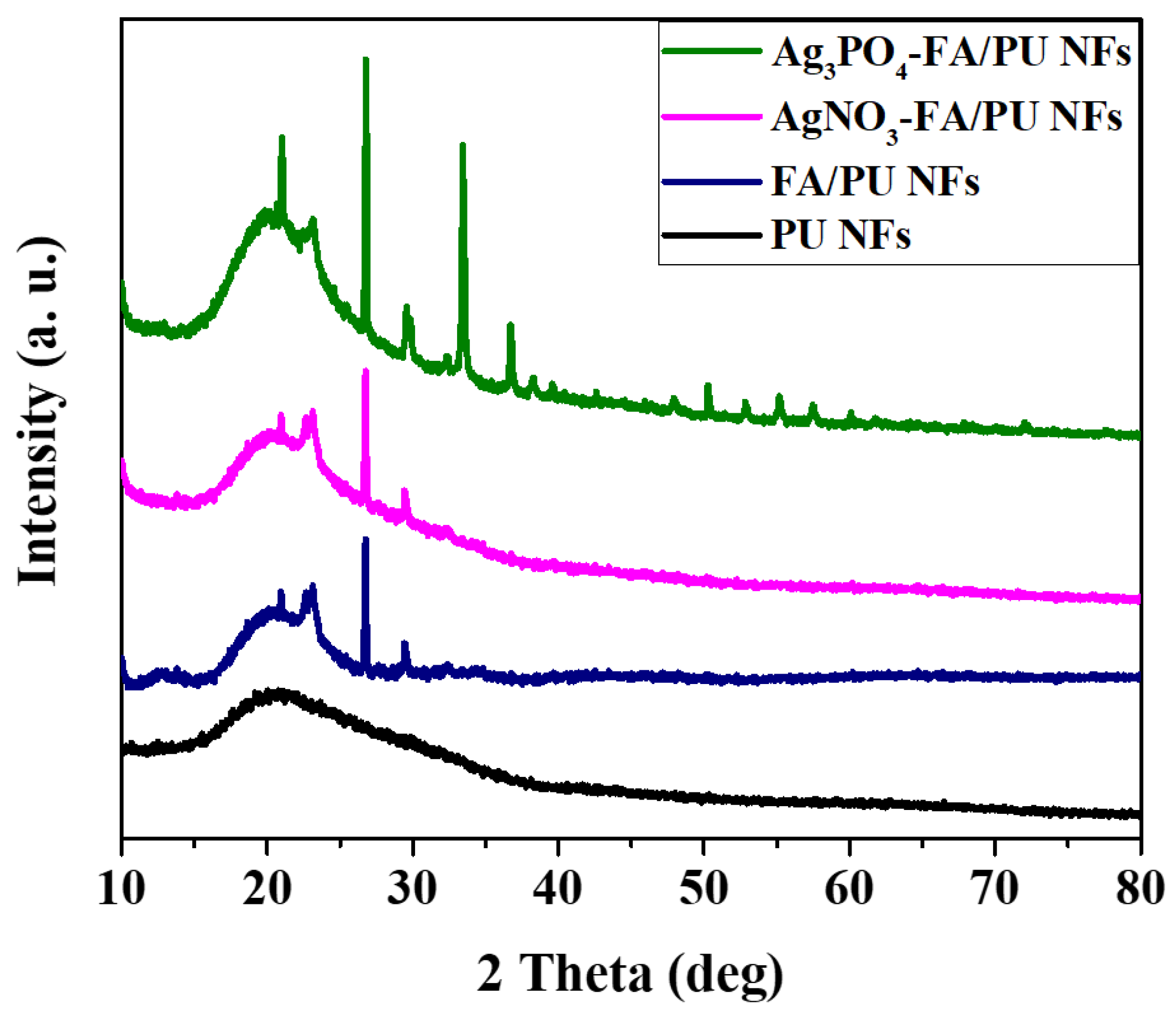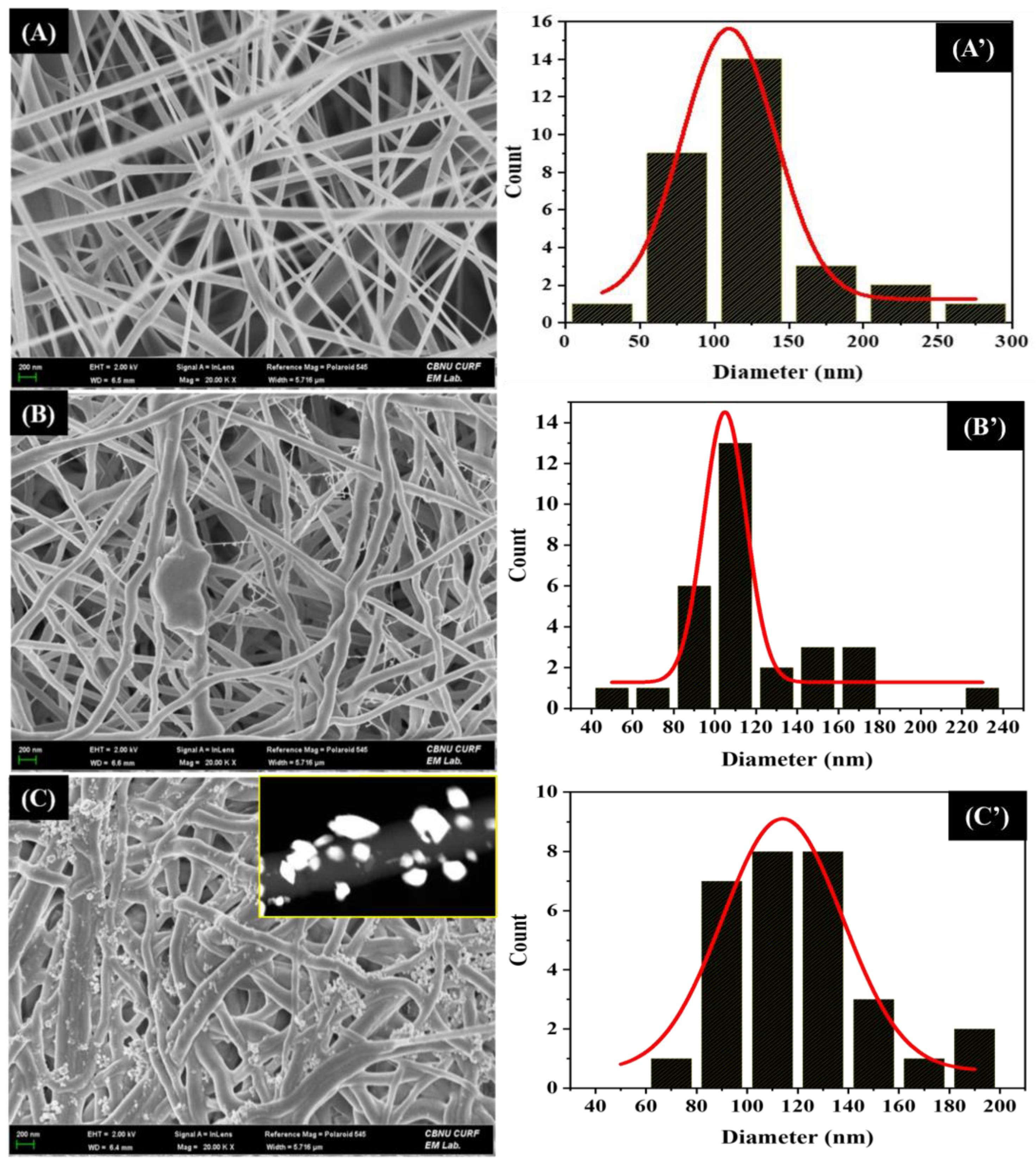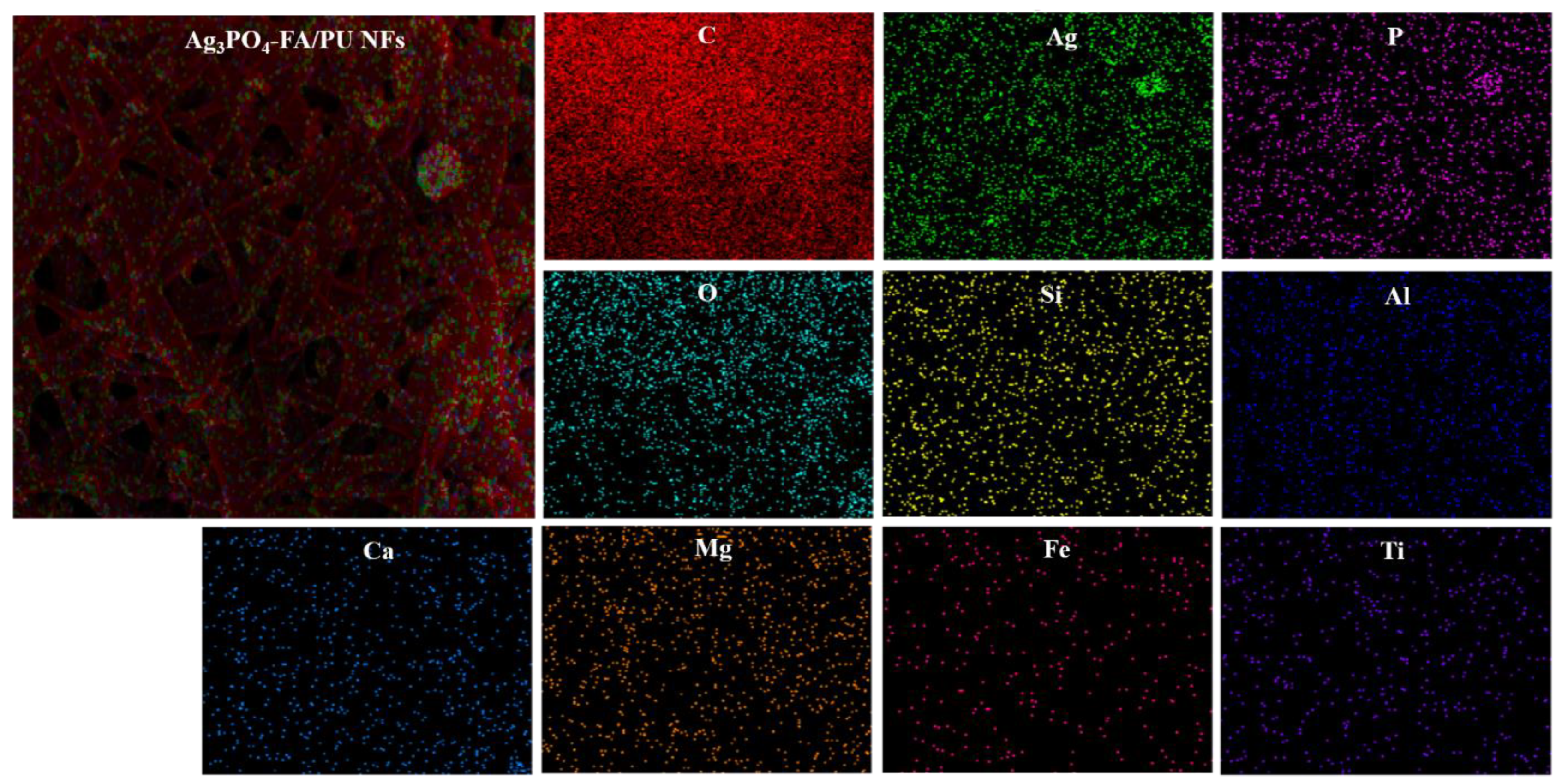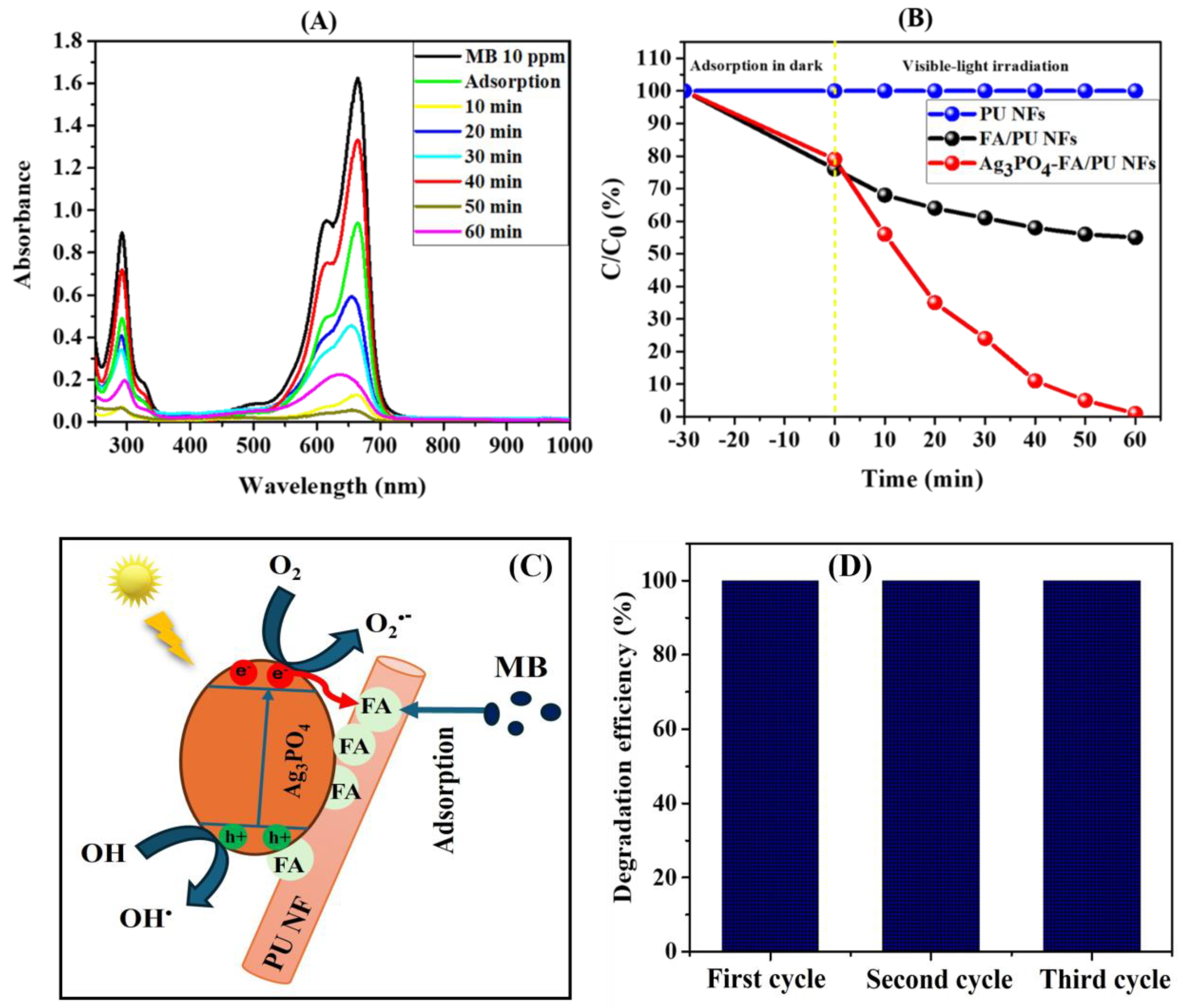Ag3PO4 Particles Decorated into Fly-Ash-Incorporated Electrospun Polyurethane Nanofibers: Simultaneously Enhanced Photocatalytic and Antibacterial Activities
Abstract
1. Introduction
2. Experimental
2.1. Materials
2.2. Preparation of AgNO3/FA/PU Nanofibers Membrane
2.3. Preparation of Ag3PO4–FA/PU Nanofiber Membrane
2.4. Characterization
2.5. Antibacterial Performance
2.6. Dye Degradation Studies
3. Results and Discussion
4. Conclusions
Author Contributions
Funding
Data Availability Statement
Conflicts of Interest
References
- Nguyen, H.-H.T.; Nguyen, H.T.; Ahmed, S.F.; Rajamohan, N.; Yusuf, M.; Sharma, A.; Arunkumar, P.; Deepanraj, B.; Tran, H.-T.; Al-Gheethi, A.; et al. Emerging waste-to-wealth applications of fly ash for environmental remediation: A review. Environ. Res. 2023, 227, 115800. [Google Scholar] [CrossRef] [PubMed]
- Zhang, Y.; Liu, L. Fly ash-based geopolymer as a novel photocatalyst for degradation of dye from wastewater. Particuology 2013, 11, 353–358. [Google Scholar] [CrossRef]
- Pant, B.; Ojha, G.P.; Kim, H.-Y.; Park, M.; Park, S.-J. Fly-ash-incorporated electrospun zinc oxide nanofibers: Potential material for environmental remediation. Environ. Pollut. 2019, 245, 163–172. [Google Scholar] [CrossRef] [PubMed]
- Chen, Y.; Fan, Y.; Huang, Y.; Liao, X.; Xu, W.; Zhang, T. A comprehensive review of toxicity of coal fly ash and its leachate in the ecosystem. Ecotoxicol. Environ. Saf. 2024, 269, 115905. [Google Scholar] [CrossRef]
- Bhatt, A.; Priyadarshini, S.; Acharath Mohanakrishnan, A.; Abri, A.; Sattler, M.; Techapaphawit, S. Physical, chemical, and geotechnical properties of coal fly ash: A global review. Case Stud. Constr. Mater. 2019, 11, e00263. [Google Scholar] [CrossRef]
- Wang, C.-Q.; Liu, K.; Huang, D.-M.; Chen, Q.; Tu, M.-J.; Wu, K.; Shui, Z.-H. Utilization of fly ash as building material admixture: Basic properties and heavy metal leaching. Case Stud. Constr. Mater. 2022, 17, e01422. [Google Scholar] [CrossRef]
- Saud, P.S.; Pant, B.; Park, M.; Chae, S.-H.; Park, S.-J.; Ei-Newehy, M.; Al-Deyab, S.S.; Kim, H.-Y. Preparation and photocatalytic activity of fly ash incorporated TiO2 nanofibers for effective removal of organic pollutants. Ceram. Int. 2015, 41, 1771–1777. [Google Scholar] [CrossRef]
- Gadore, V.; Ahmaruzzaman, M. Fly ash–based nanocomposites: A potential material for effective photocatalytic degradation/elimination of emerging organic pollutants from aqueous stream. Environ. Sci. Pollut. Res. 2021, 28, 46910–46933. [Google Scholar] [CrossRef]
- Aigbe, U.O.; Ukhurebor, K.E.; Onyancha, R.B.; Osibote, O.A.; Darmokoesoemo, H.; Kusuma, H.S. Fly ash-based adsorbent for adsorption of heavy metals and dyes from aqueous solution: A review. J. Mater. Res. Technol. 2021, 14, 2751–2774. [Google Scholar] [CrossRef]
- Alinnor, I.J. Adsorption of heavy metal ions from aqueous solution by fly ash. Fuel 2007, 86, 853–857. [Google Scholar] [CrossRef]
- Park, M.; Kuk, Y.-S.; Kwon, O.H.; Acharya, J.; Ojha, G.P.; Ko, J.-K.; Kong, H.-S.; Pant, B. Fly Ash-Incorporated Polystyrene Nanofiber Membrane as a Fire-Retardant Material: Valorization of Discarded Materials. Nanomaterials 2022, 12, 3811. [Google Scholar] [CrossRef] [PubMed]
- Wang, S.; Ma, Q.; Zhu, Z.H. Characteristics of coal fly ash and adsorption application. Fuel 2008, 87, 3469–3473. [Google Scholar] [CrossRef]
- Eteba, A.; Bassyouni, M.; Saleh, M. Utilization of chemically modified coal fly ash as cost-effective adsorbent for removal of hazardous organic wastes. Int. J. Environ. Sci. Technol. 2023, 20, 7589–7602. [Google Scholar] [CrossRef]
- Ökte, A.N.; Karamanis, D.; Tuncel, D. Dual functionality of TiO2-flyash nanocomposites: Water vapor adsorption and photocatalysis. Catal. Today 2014, 230, 205–213. [Google Scholar] [CrossRef]
- Rafaie, H.A.; Ramli, N.I.T.; Khusaimi, Z.; Mohd Sarjidan, M.A.; Dulyaseree, P.; Hir, Z.A.M. Ag2CO3-Based Photocatalyst with Enhanced Photocatalytic Activity for Endocrine-Disrupting Chemicals Degradation: A Review. Catalysts 2023, 13, 540. [Google Scholar] [CrossRef]
- Pant, B.; Park, M.; Park, S.-J. Hydrothermal synthesis of Ag2CO3-TiO2 loaded reduced graphene oxide nanocomposites with highly efficient photocatalytic activity. Chem. Eng. Commun. 2020, 207, 688–695. [Google Scholar] [CrossRef]
- Pant, B.; Prasad Ojha, G.; Acharya, J.; Park, M. Ag3PO4-TiO2-Carbon nanofiber Composite: An efficient Visible-light photocatalyst obtained from electrospinning and hydrothermal methods. Sep. Purif. Technol. 2021, 276, 119400. [Google Scholar] [CrossRef]
- Qian, Y.; Shi, J.; Yang, X.; Yuan, Y.; Liu, L.; Zhou, G.; Yi, J.; Wang, X.; Wang, S. Integration of biochar into Ag3PO4/α-Fe2O3 heterojunction for enhanced reactive oxygen species generation towards organic pollutants removal. Environ. Pollut. 2022, 303, 119131. [Google Scholar] [CrossRef]
- Tavakoli, F.; Badiei, A.; Mohammadi Ziarani, G.; Tarighi, S. Photocatalytic Application of TiO2–AgI Hybrid for Degradation of Organic Pollutants in Water. Int. J. Environ. Res. 2017, 11, 217–224. [Google Scholar] [CrossRef]
- Su, J.; Fan, Y.; Yan, Y.; Liu, T.; Li, H.; Li, Z.; Song, F. A one-pot synthesis of AgBr/Ag3PO4 composite photocatalysts. RSC Adv. 2021, 11, 9865–9873. [Google Scholar] [CrossRef]
- Saud Prem, S.; Ghouri Zafar, K.; Pant, B.; An, T.; Lee Joong, H.; Park, M.; Kim, H.-Y. Photocatalytic degradation and antibacterial investigation of nano synthesized Ag3VO4 particles @PAN nanofibers. Carbon Lett. 2016, 18, 30–36. [Google Scholar] [CrossRef]
- Thiyagarajan, S.; Singh, S.; Bahadur, D. Reusable sunlight activated photocatalyst Ag3PO4 and its significant antibacterial activity. Mater. Chem. Phys. 2016, 173, 385–394. [Google Scholar] [CrossRef]
- Al Kausor, M.; Gupta, S.S.; Chakrabortty, D. Ag3PO4-based nanocomposites and their applications in photodegradation of toxic organic dye contaminated wastewater: Review on material design to performance enhancement. J. Saudi Chem. Soc. 2020, 24, 20–41. [Google Scholar] [CrossRef]
- Luo, L.; Li, Y.; Hou, J.; Yang, Y. Visible photocatalysis and photostability of Ag3PO4 photocatalyst. Appl. Surf. Sci. 2014, 319, 332–338. [Google Scholar] [CrossRef]
- Krungchanuchat, S.; Ekthammathat, N.; Phuruangrat, A.; Thongtem, S.; Thongtem, T. High UV-visible photocatalytic activity of Ag3PO4 dodecahedral particles synthesized by a simple hydrothermal method. Mater. Lett. 2017, 201, 58–61. [Google Scholar] [CrossRef]
- Saud, P.S.; Pant, B.; Ojha, G.P.; Kim, D.-U.; Kuk, Y.-S.; Park, S.-J.; Park, M.; Kim, H.-Y. One-pot synthesis of Ag3PO4/MoS2 nanocomposite with highly efficient photocatalytic activity. J. Environ. Chem. Eng. 2017, 5, 5521–5527. [Google Scholar] [CrossRef]
- Ma, P.; Yu, Y.; Xie, J.; Fu, Z. Ag3PO4/CuO composites utilizing the synergistic effect of photocatalysis and Fenton-like catalysis to dispose organic pollutants. Adv. Powder Technol. 2017, 28, 2797–2804. [Google Scholar] [CrossRef]
- Lu, J.; Wang, Y.; Liu, F.; Zhang, L.; Chai, S. Fabrication of a direct Z-scheme type WO3/Ag3PO4 composite photocatalyst with enhanced visible-light photocatalytic performances. Appl. Surf. Sci. 2017, 393, 180–190. [Google Scholar] [CrossRef]
- Liu, L.; Qi, Y.; Lu, J.; Lin, S.; An, W.; Liang, Y.; Cui, W. A stable Ag3PO4@g-C3N4 hybrid core@shell composite with enhanced visible light photocatalytic degradation. Appl. Catal. B Environ. 2016, 183, 133–141. [Google Scholar] [CrossRef]
- Liu, W.; Wang, M.; Xu, C.; Chen, S.; Fu, X. Ag3PO4/ZnO: An efficient visible-light-sensitized composite with its application in photocatalytic degradation of Rhodamine B. Mater. Res. Bull. 2013, 48, 106–113. [Google Scholar] [CrossRef]
- Pant, B.; Park, M.; Park, S.-J. Drug Delivery Applications of Core-Sheath Nanofibers Prepared by Coaxial Electrospinning: A Review. Pharmaceutics 2019, 11, 305. [Google Scholar] [CrossRef] [PubMed]
- Govind Kumar, S.; Nirmala Rachel, J. Electrospinning: The Technique and Applications. In Recent Developments in Nanofibers Research; Maaz, K., Samson Jerold Samuel, C., Eds.; IntechOpen: Rijeka, Croatia, 2022; Chapter 1. [Google Scholar]
- Pant, B.; Park, M.; Park, S.-J. MoS2/CdS/TiO2 ternary composite incorporated into carbon nanofibers for the removal of organic pollutants from water. Inorg. Chem. Commun. 2019, 102, 113–119. [Google Scholar] [CrossRef]
- Pathak, D.; Sharma, A.; Sharma, D.P.; Kumar, V. A review on electrospun nanofibers for photocatalysis: Upcoming technology for energy and environmental remediation applications. Appl. Surf. Sci. Adv. 2023, 18, 100471. [Google Scholar] [CrossRef]
- Samadi, M.; Moshfegh, A.Z. Recent Developments of Electrospinning-Based Photocatalysts in Degradation of Organic Pollutants: Principles and Strategies. ACS Omega 2022, 7, 45867–45881. [Google Scholar] [CrossRef]
- Yousef, A.; Barakat, N.A.M.; Al-Deyab, S.S.; Nirmala, R.; Pant, B.; Kim, H.Y. Encapsulation of CdO/ZnO NPs in PU electrospun nanofibers as novel strategy for effective immobilization of the photocatalysts. Colloids Surf. A Physicochem. Eng. Asp. 2012, 401, 8–16. [Google Scholar] [CrossRef]
- Yu, H.; Jiao, Z.; Hu, H.; Lu, G.; Ye, J.; Bi, Y. Fabrication of Ag3PO4–PAN composite nanofibers for photocatalytic applications. CrystEngComm 2013, 15, 4802–4805. [Google Scholar] [CrossRef]
- Habib, Z.; Lee, C.-G.; Li, Q.; Khan, S.J.; Ahmad, N.M.; Jamal, Y.; Huang, X.; Javed, H. Bi-Polymer Electrospun Nanofibers Embedding Ag3PO4/P25 Composite for Efficient Photocatalytic Degradation and Anti-Microbial Activity. Catalysts 2020, 10, 784. [Google Scholar] [CrossRef]
- Pant, B.; Park, M.; Park, S.-J. One-Step Synthesis of Silver Nanoparticles Embedded Polyurethane Nano-Fiber/Net Structured Membrane as an Effective Antibacterial Medium. Polymers 2019, 11, 1185. [Google Scholar] [CrossRef]
- Pant, B.; Munkhtur, E.; Prasad Ojha, G.; Acharya, J.; Hong, S.-T.; Park, M. Hydrothermally synthesized ZnO/WS2 composite with impressive photocatalytic, antibacterial, and electrochemical performances. Inorg. Chem. Commun. 2024, 166, 112630. [Google Scholar] [CrossRef]
- Li, J.; Ji, X.; Li, X.; Hu, X.; Sun, Y.; Ma, J.; Qiao, G. Preparation and photocatalytic degradation performance of Ag3PO4 with a two-step approach. Appl. Surf. Sci. 2016, 372, 30–35. [Google Scholar] [CrossRef]
- Pant, H.R.; Kim, H.J.; Joshi, M.K.; Pant, B.; Park, C.H.; Kim, J.I.; Hui, K.S.; Kim, C.S. One-step fabrication of multifunctional composite polyurethane spider-web-like nanofibrous membrane for water purification. J. Hazard. Mater. 2014, 264, 25–33. [Google Scholar] [CrossRef] [PubMed]
- Gu, X.; Li, N.; Luo, J.; Xia, X.; Gu, H.; Xiong, J. Electrospun polyurethane microporous membranes for waterproof and breathable application: The effects of solvent properties on membrane performance. Polym. Bull. 2018, 75, 3539–3553. [Google Scholar] [CrossRef]
- Jirofti, N.; Mohebbi-Kalhori, D.; Samimi, A.; Hadjizadeh, A.; Kazemzadeh, G.H. Fabrication and characterization of a novel compliant small-diameter PET/PU/PCL triad-hybrid vascular graft. Biomed. Mater. 2020, 15, 055004. [Google Scholar] [CrossRef]
- Joshi, M.K.; Pant, H.R.; Liao, N.; Kim, J.H.; Kim, H.J.; Park, C.H.; Kim, C.S. In-situ deposition of silver−iron oxide nanoparticles on the surface of fly ash for water purification. J. Colloid Interface Sci. 2015, 453, 159–168. [Google Scholar] [CrossRef]
- Tong, Z.W.; Yang, D.; Sun, Y.Y.; Tian, Y.; Jiang, Z.Y. In situ fabrication of Ag3PO4/TiO2 nanotube heterojunctions with enhanced visible-light photocatalytic activity. Phys. Chem. Chem. Phys. 2015, 17, 12199–12206. [Google Scholar] [CrossRef]
- Dinh, N.T.; Vo, L.N.H.; Tran, N.T.T.; Phan, T.D.; Nguyen, D.B. Enhancing the removal efficiency of methylene blue in water by fly ash via a modified adsorbent with alkaline thermal hydrolysis treatment. RSC Adv. 2021, 11, 20292–20302. [Google Scholar] [CrossRef]
- Yu, C.; Chen, X.; Li, N.; Zhang, Y.; Li, S.; Chen, J.; Yao, L.; Lin, K.; Lai, Y.; Deng, X. Ag3PO4-based photocatalysts and their application in organic-polluted wastewater treatment. Environ. Sci. Pollut. Res. 2022, 29, 18423–18439. [Google Scholar] [CrossRef]
- Pant, B.; Jung, S.; Park, M. Ion-exchange formation of Ag2CO3-Ag3PO4 binary nanostructure on electrospun polyurethane nanofibers for enhanced photocatalytic degradation and antibacterial activities. Mater. Today Commun. 2024, 41, 110913. [Google Scholar] [CrossRef]
- Xiong, S.; Liu, M.; Yan, J.; Zhao, Z.; Wang, H.; Yin, X.; Wang, L.; Chen, S. Immobilization of Ag3PO4 nanoparticles on chitosan fiber for photocatalytic degradation of methyl orange. Cellulose 2018, 25, 5007–5015. [Google Scholar] [CrossRef]
- Tao, R.; Yang, S.; Shao, C.; Li, X.; Li, X.; Liu, S.; Zhang, J.; Liu, Y. Reusable and Flexible g-C3N4/Ag3PO4/Polyacrylonitrile Heterojunction Nanofibers for Photocatalytic Dye Degradation and Oxygen Evolution. ACS Appl. Nano Mater. 2019, 2, 3081–3090. [Google Scholar] [CrossRef]
- Liu, J.; Liang, H.; Xing, Z.; Wang, X.; Bai, J. Synthesis of Bi-BiPO4-Ag3PO4/PAN composite nanomaterial photocatalyst with the degradation performance for rhodamine B. Mater. Sci. Semicond. Process. 2025, 185, 108918. [Google Scholar] [CrossRef]
- Dânoun, K.; Tabit, R.; Laghzizil, A.; Zahouily, M. A novel approach for the synthesis of nanostructured Ag3PO4 from phosphate rock: High catalytic and antibacterial activities. BMC Chem. 2021, 15, 42. [Google Scholar] [CrossRef] [PubMed]
- Xu, J.-W.; Gao, Z.-D.; Han, K.; Liu, Y.; Song, Y.-Y. Synthesis of Magnetically Separable Ag3PO4/TiO2/Fe3O4 Heterostructure with Enhanced Photocatalytic Performance under Visible Light for Photoinactivation of Bacteria. ACS Appl. Mater. Interfaces 2014, 6, 15122–15131. [Google Scholar] [CrossRef]
- Lyu, Y.-h.; Wei, F.; Zhang, T.; Luo, L.; Pan, Y.; Yang, X.; Yu, H.; Zhou, S. Different antibacterial effect of Ag3PO4/TiO2 heterojunctions and the TiO2 polymorphs. J. Alloys Compd. 2021, 876, 160016. [Google Scholar] [CrossRef]
- Agbe, H.; Sarkar, D.K.; Chen, X.G. Electrochemically synthesized silver phosphate coating on anodized aluminum with superior antibacterial properties. Surf. Coat. Technol. 2021, 428, 127892. [Google Scholar] [CrossRef]






| SN | Photocatalyst | Pollutant | Light Source | Degradation (%)/time | Ref. |
| 1 | Ag2CO3–Ag3PO4/PU NFs | Methylene blue (10 ppm) | 300 W, Xe lamp | 100 %/70 min | [49] |
| 2 | Ag3PO4/chitosan NFs | Methyl orange | 300 W, Xe lamp | 93.8 %/80 min | [50] |
| 3 | g-C3N4/Ag3PO4/PAN NFs | Rhodamine B (10 mg/L) | 150 W, Xe lamp | 96 %/120 min | [51] |
| 4 | Ag3PO4/P25/PMMA/PVP NFs | Methyl orange (10 mg/L) | Six 8W Fluorescent lamp | 100 %/150 min | [38] |
| 5 | Bi-BiPO4–Ag3PO4/PAN | Rhodamine B (10 mg/L) | 330 W, XE lamp | 93.7 %/180 min | [52] |
| 6 | Ag3PO4–FA/PU NFs | Methylene blue (10 ppm) | 300 W, Xe lamp | 98 %/60 min | This study |
Disclaimer/Publisher’s Note: The statements, opinions and data contained in all publications are solely those of the individual author(s) and contributor(s) and not of MDPI and/or the editor(s). MDPI and/or the editor(s) disclaim responsibility for any injury to people or property resulting from any ideas, methods, instructions or products referred to in the content. |
© 2025 by the authors. Licensee MDPI, Basel, Switzerland. This article is an open access article distributed under the terms and conditions of the Creative Commons Attribution (CC BY) license (https://creativecommons.org/licenses/by/4.0/).
Share and Cite
Pant, B.; Kim, A.A.; Munkhtur, E.; Park, M. Ag3PO4 Particles Decorated into Fly-Ash-Incorporated Electrospun Polyurethane Nanofibers: Simultaneously Enhanced Photocatalytic and Antibacterial Activities. Photochem 2025, 5, 6. https://doi.org/10.3390/photochem5010006
Pant B, Kim AA, Munkhtur E, Park M. Ag3PO4 Particles Decorated into Fly-Ash-Incorporated Electrospun Polyurethane Nanofibers: Simultaneously Enhanced Photocatalytic and Antibacterial Activities. Photochem. 2025; 5(1):6. https://doi.org/10.3390/photochem5010006
Chicago/Turabian StylePant, Bishweshwar, Allison A. Kim, Enkhtsatsaral Munkhtur, and Mira Park. 2025. "Ag3PO4 Particles Decorated into Fly-Ash-Incorporated Electrospun Polyurethane Nanofibers: Simultaneously Enhanced Photocatalytic and Antibacterial Activities" Photochem 5, no. 1: 6. https://doi.org/10.3390/photochem5010006
APA StylePant, B., Kim, A. A., Munkhtur, E., & Park, M. (2025). Ag3PO4 Particles Decorated into Fly-Ash-Incorporated Electrospun Polyurethane Nanofibers: Simultaneously Enhanced Photocatalytic and Antibacterial Activities. Photochem, 5(1), 6. https://doi.org/10.3390/photochem5010006











